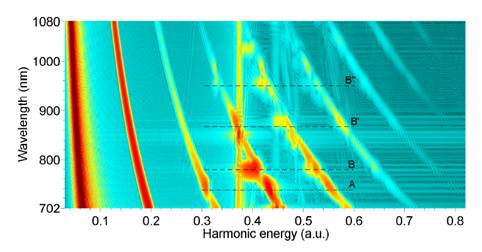Time:2014-06-12ClickTimes:
The team of Prof. Liang-you Peng and Prof. Qihuang Gong of the State Key
Laboratory for Mesoscopic Physics and Department of Physics have made important
progress in the mechanisms of below threshold harmonic generation. Their results
have been published by Physics Review Letters [Phys. Rev. Lett. 112, 233001
(2014)].
The harmonic generation when atoms or molecules interact with strong laser
field has been paid lots of attention during the last decades due to its
application as coherent XUV and attosecond light sources. When the photon energy
emitted is large enough, theories without consideration of the Coulomb potential
such as strong field approximation can describe this process. But for the low
energy photons, Coulomb potential have critical impact on the harmonic yield and
analytical theory does not exist in this range. They numerically solve the
time-dependent Schrödinger equation of an atom to investigate the mechanisms in
the low energy range by varying the laser wavelength and peak intensity.

|
FIG. 1. Harmonic spectra of hydrogen interacting with an intense driving laser at a
peak intensity I0=6×1012 W/cm2, with the laser wavelength changed from 702 to 1080 nm.
|
The harmonic spectrum with different laser wavelengths is shown in Fig.1. The
harmonic yield is modulated by the laser wavelength. Their analysis through a
semi-classical model and the generalized quantum path analysis explained these
structures. On the one hand, they confirmed the quantum path interference in
this energy range. On the other hand, they identified the influence of Coulomb
potential when bound states act as intermediate state during the harmonic
generation process. Their theory can help to understand the experimental result
of the frequency comb and coherent light sources in EUV range.
This work is supported by the 973 Program under Grant No. 2013CB922402, by
the National Natural Science Foundation of China under Grants No. 11322437, No.
11174016, and No. 11121091, and by the Program for New Century Excellent Talents
in University (NCET). The computational results were obtained by using the
computer cluster “MESO” in the State Key Laboratory for Mesoscopic Physics at
Peking University.
